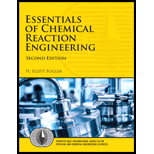
Rework Example
Interpretation:
The given reaction rates for the given reaction are to be determined and compared with the results provided.
Concept Introduction:
For any given reaction, its rate defines the speed at which the moles of a chemical species get consumed to form other chemical species. For a chemical species A , the reaction rate is represented by
Equation 3-1 to be used for the reaction
is:
Here,
Answer to Problem 1.2Q
Rate of disappearance of A ,
Rate of formation of A ,
Rate of disappearance of B ,
Rate of formation of B ,
Rate of formation of C ,
Rate of disappearance of C ,
Rate of formation of D ,
Rate of disappearance of D ,
Explanation of Solution
Given information:
The consumption rate of Chloral (A) is given as 10 moles per second per
when it reacts with chlorobenzene (B) according to the reaction:
The results are as follows:
Rate of disappearance of A ,
Rate of formation of A ,
Rate of disappearance of B ,
Rate of formation of B ,
Rate of formation of C ,
Rate of disappearance of C ,
Rate of formation of D ,
Rate of disappearance of D ,
The calculated rates of formation and disappearance of
For the given reaction of chloral and chlorobenzene is:
Stoichiometric coefficients of
are:
From equation (1),
The rate of consumption/disappearance of chloral (A) is given as,
Thus, the rate of formation of A will be,
From the first two terms of equation (2), the rate of disappearance of B is
The rate of formation of B will be,
From the first and third terms of equation (2), the rate of appearance of C is,
The rate of disappearance of C will be,
From the first and fourth terms of equation (2), the rate of appearance of D is,
The rate of disappearance of D will be,
All the rates of formation and disappearance of
Thus,
Rate of disappearance of A ,
Rate of formation of A ,
Rate of disappearance of B ,
Rate of formation of B ,
Rate of formation of C ,
Rate of disappearance of C ,
Rate of formation of D ,
Rate of disappearance of D ,
Want to see more full solutions like this?
Chapter 1 Solutions
Essentials of Chemical Reaction Engineering (2nd Edition) (Prentice Hall International Series in the Physical and Chemical Engineering Sciences)
 Introduction to Chemical Engineering Thermodynami...Chemical EngineeringISBN:9781259696527Author:J.M. Smith Termodinamica en ingenieria quimica, Hendrick C Van Ness, Michael Abbott, Mark SwihartPublisher:McGraw-Hill Education
Introduction to Chemical Engineering Thermodynami...Chemical EngineeringISBN:9781259696527Author:J.M. Smith Termodinamica en ingenieria quimica, Hendrick C Van Ness, Michael Abbott, Mark SwihartPublisher:McGraw-Hill Education Elementary Principles of Chemical Processes, Bind...Chemical EngineeringISBN:9781118431221Author:Richard M. Felder, Ronald W. Rousseau, Lisa G. BullardPublisher:WILEY
Elementary Principles of Chemical Processes, Bind...Chemical EngineeringISBN:9781118431221Author:Richard M. Felder, Ronald W. Rousseau, Lisa G. BullardPublisher:WILEY Elements of Chemical Reaction Engineering (5th Ed...Chemical EngineeringISBN:9780133887518Author:H. Scott FoglerPublisher:Prentice Hall
Elements of Chemical Reaction Engineering (5th Ed...Chemical EngineeringISBN:9780133887518Author:H. Scott FoglerPublisher:Prentice Hall
 Industrial Plastics: Theory and ApplicationsChemical EngineeringISBN:9781285061238Author:Lokensgard, ErikPublisher:Delmar Cengage Learning
Industrial Plastics: Theory and ApplicationsChemical EngineeringISBN:9781285061238Author:Lokensgard, ErikPublisher:Delmar Cengage Learning Unit Operations of Chemical EngineeringChemical EngineeringISBN:9780072848236Author:Warren McCabe, Julian C. Smith, Peter HarriottPublisher:McGraw-Hill Companies, The
Unit Operations of Chemical EngineeringChemical EngineeringISBN:9780072848236Author:Warren McCabe, Julian C. Smith, Peter HarriottPublisher:McGraw-Hill Companies, The





